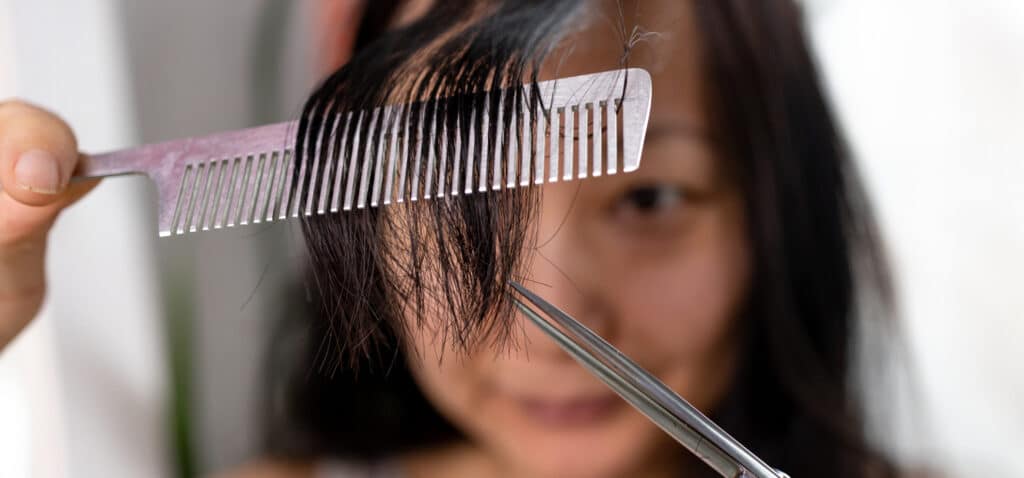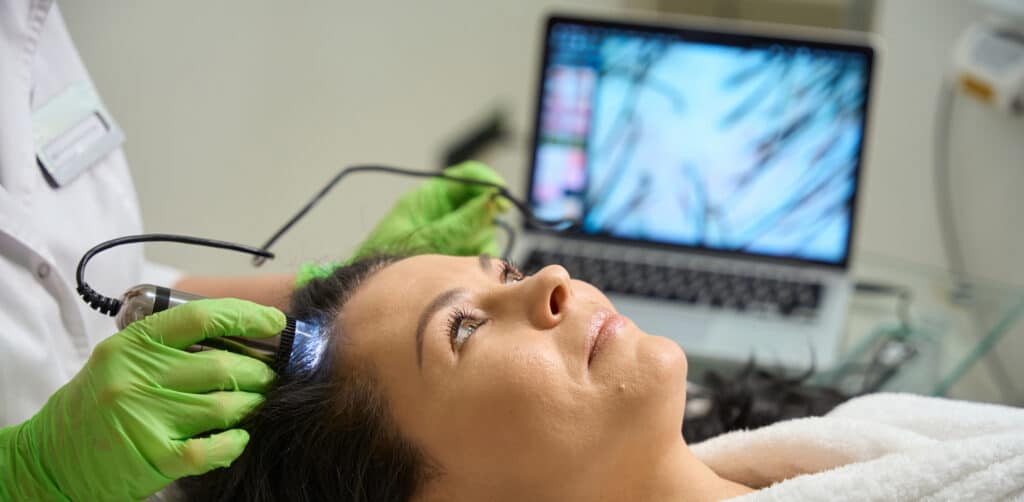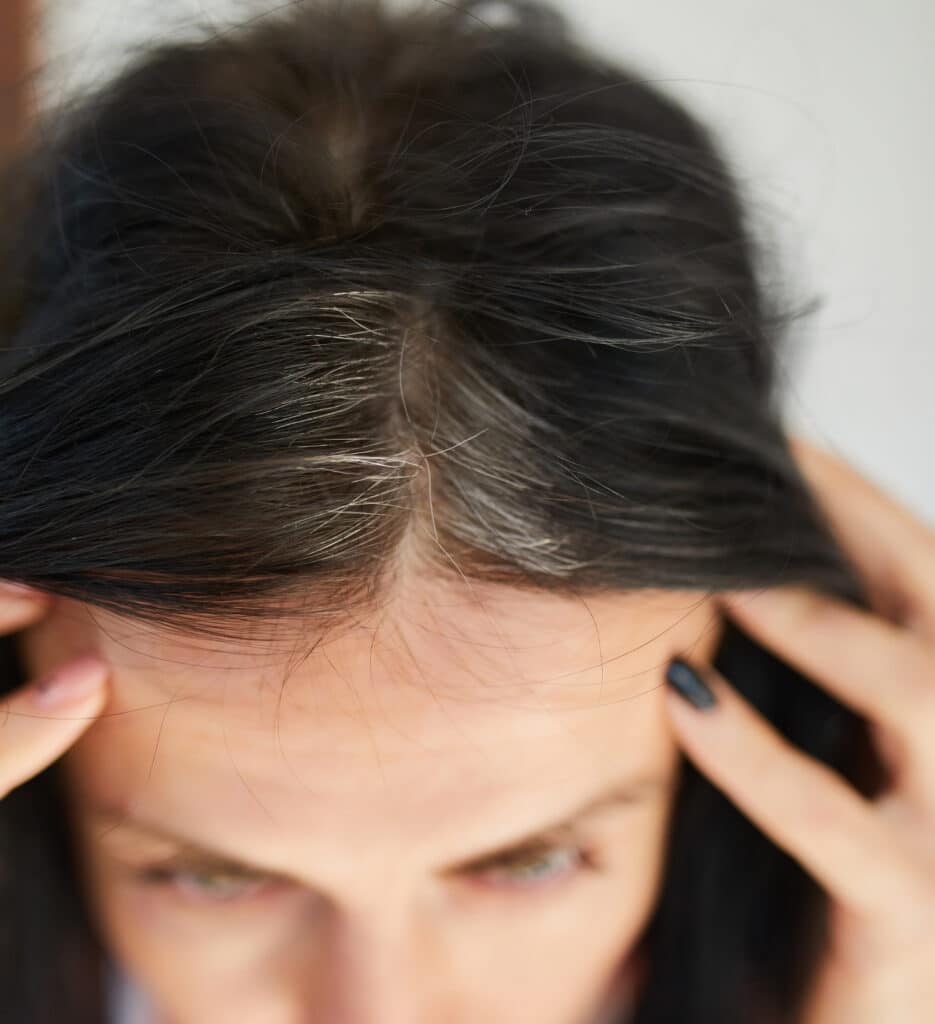Thinning hair perimenopause or postmenopause is a real problem many women face today. But the good news is there are ways to manage menopausal hair loss. Let’s understand what happens, before going forward with how to deal with thinning hair during perimenopause. Shall we?
What is Perimenopause?
Perimenopause is actually a transition period leading up to menopause and commences post 40. However, it could also start in the 30s, depending on various factors.
During this period women go through a lot of physiological changes, most notably the decline in estrogen levels. The decline in female hormones or their imbalance combined with other factors trigger menopausal symptoms associated with perimenopause including hot flashes, mood swings, hair shedding and yes, hair thinning.
How & Why Does Perimenopause Affect Hair?
We all know menopausal hair loss is common during perimenopause. But what causes it, exactly? Let’s explore more on that to understand better.
Perimenopause is a period that leads to a transition and leading up to that there are hormonal fluctuations, mood swings, hot flashes, irregular periods, etc. Most notably, there’s a decline in the female hormone levels or an imbalance of hormones.
The decline of two hormones names progesterone and estrogen are the reason behind many symptoms This stage is characterized by hormonal fluctuations, particularly a decline in estrogen and progesterone levels, leading to a variety of symptoms including irregular periods, hair breakage, weight gain, hot flashes, mood swings, and yes, thinning hair. Did you know the hormonal changes also affect one’s blood vessels?
Hair Growth Cycle & Hormone Fluctuations
Knowing how our hair grows helps understand what’s happening better. We all know hair growth happens in phases. There are four stages – anagen, catagen, telogen and exogen phases in the hair growth cycle.
Anagen is the phase where hair grows actively. Catagen or the transition phase is when hair growth slows down and the hair strands detach from the hair follicles. Telogen is the resting phase. Exogen or the shedding phase is where old hair falls out and make way for a new one. The cycle begins and goes on – rinse and repeat!
During perimenopause, there’s an imbalance in hormone levels causing disruption to this cycle. This leads to more hair strands entering the telogen or shedding phase, thus resulting in perimenopausal hair loss and thinning.
What Causes Hair Loss During Perimenopause?

We have already covered that a lot of changes happen during this time. Let’s take a look at few common causes of perimenopausal hair loss in women.
Androgenetic alopecia or androgenic alopecia is a hereditary hair loss condition in women that’s caused due to excessive male hormones. You probably know it as female pattern baldness. It leads to hair thinning and hair loss, at times, balding. Did you know female pattern baldness strikes perimenopause or during or post menopause?
Chronic telogen effluvium is a type of hair loss that affects women during menopause. Hair typically enters resting stage prematurely. This leads to hair loss that’s termed telogen effluvium.
Hormonal changes, of course, goes without saying considering we’re talking about perimenopause. While there’s a decline in estrogen and progesterone levels, the male hormone androgen levels go up, which greatly contribute to the hair loss in menopausal women.
Needless to say, stress! Can such a big change happen in our life and we’re not stressed? Did you know stress triggers or worsens female pattern hair loss? Stress also impacts our hair follicles in different ways.
Besides these, there could be other causes that exacerbate perimenopausal hair loss including underlying health conditions, certain medications or treatments, nutritional deficiencies, etc.
Did you know your hair follicles shrink during menopause and that’s why hair thinning happens?
Symptoms to Look Out For
You probably have thicker and fuller hair and often don’t notice if you’re experiencing hair loss. But few symptoms help identify it in a timely fashion. Let’s take a look at what you need to watch out for.
Hair loss – it might not be obvious, especially when starting off at 50 – 100 strands but progresses and persists.
Hair texture changes and can become fine, brittle or even change texture altogether. I have seen hair changing to fine hair from fairly thick hair in postmenopausal women.
Diffuse thinning of hair is more common in women, though some might lose hair in patches especially at the back of the head.
Receding hairline or widening hair part is another sign to watch out for.
Last but not the least – hair thinning. It could happen like an overall thinning due to loss of hair all over one’s scalp, but the process could be gradual.
There are other symptoms too, but these are the most common ones. A lot of symptoms overlap with androgenetic alopecia but it’s important to diagnose before plunging into treatments.
How to Prevent or Manage Thinning Hair?
While thinning is a reality for many women, it doesn’t have to be. Wondering if there’s something you can do? Yes, let’s check out what we can do. Shall we?
Do you smoke? If yes, stop! Do you drink? If yes, stop! In a roundabout way, stop any damaging habits including mainlining on coffee or tea! As a coffee lover, I can understand the urge! But when you want to be healthy and sport stunning locks, moderation is the key.
Have a well balanced diet that includes all the key nutrients. Balanced diet not only keeps you healthy, but also your hair follicles nourished. It’s important to understand beauty starts from within – so only external measures like masks aren’t enough. Feed yourself right and keep yourself healthy!
Have you tried stress management techniques like meditation? Taking up a hobby or sport you love? Even exercising regularly helps combat stress! That’s a great motivation, isn’t it? You can be fit and also stress-free!
Some women have been able to curb and prevent thinning of hair through hormone replacement therapy for hormonal balance. Have you spoken to your physician about it?
Love styling? Who doesn’t? But styling, especially heat and chemical treatments can be really damaging. They often lead to hair loss, hair thinning and whatnot. Keep styling to a bare minimum if you can’t avoid it altogether.
Have a hair care routine and follow it religiously. Gentle hair care helps keep your hair healthy and happy. Also, when buying products for your hair or scalp, make sure they’re gentle and free from harmful ingredients.
Natural Remedies & Measures to Combat Hair Thinning
When dealing with menopause and experiencing significant hair loss, there are natural remedies and solutions that can help. Let’s take a look at a few to get you started.

Herbal Remedies
Needless to say, herbal remedies are now more sought after and increasingly more women choose them before opting for invasive procedures like hair transplant or other treatment options. Let’s take a look at a few options when considering herbal remedies.
Nettle
Rich in silica, nettle can significantly improve hair health and leave you with stronger hair. You can brew it as a tea and use it as your final rinse for best results.
Aloe Vera
Richly nourishing and hydrating, aloe vera can soothe an irritated scalp and promote hair growth. If you are OK with the smell, or can mask it with essential oils, you can also use it as a leave-in.
You can apply the gel to your hair and scalp and wash off after 25 minutes. It leaves you with soft and shiny hair.
ACV
Do you know ACV rinse can clear scalp buildup and leave your scalp clear and happy? It is also a conducive environment for growth, right?
Just add 1/4 cup to a liter of water and use it as your final rinse. You can also add a few spoons to your hair masks.
Coconut Milk
Have you ever tried coconut milk for your hair? It’s a protein-rich hair food that can work wonders for your hair and scalp.
You can prepare a nourishing and hydrating mask with coconut milk and a spoon of honey. Apply it to your hair and scalp and wash off after 30 minutes for stunning hair.
Not only does coconut milk strengthen hair and prevent breakage, it nourishes your hair and scalp.
Scalp Treatments
A healthy scalp ensures healthy hair follicles, which means improved hair regrowth and growth. The two most common scalp treatment methods are massage related. In Sujok, they also wear a scalp cap for a few minutes everyday. Have you heard about this?
Scalp Massage: Scalp massage offers loads of benefits including stimulating hair follicles and fostering an environment that is ideal for promoting hair growth. Numerous traditional medicine methods have different explanations for why this works, including the stimulation of energy points on the surface of the scalp.
Massage also increases blood flow to the scalp, resulting in adequate if not more nutrition and oxygen availability.
You can massage for a few minutes everyday or comb through using a wooden or metal comb. Do you know those enduring alopecia areata have seen positive changes post incorporating scalp massage to their routine?
Oil Massage: Like the dry massage, this too takes a similar route. The exception being the addition of oils for the massage. I love a good pre-shower warm oil massage and that seems to promote healthy hair growth and keeps hair disorders at bay.
Supplements
We can’t skip over supplements considering how important nutrients are for proper hair growth. Have you tried supplements to keep hair healthy before? There’s a reason we recommend Vitamins Revive Hair Growth Vitamins when facing perimenopausal hair loss and thinning.
Nutrients like biotin, vitamin D, fatty acids, iron, zinc and other essential nutrients have a key role to play when combatting hair shedding and thinning. I notice positive changes with my hair and scalp health when taking natural supplements.
Did you know some supplements also help combat the symptoms that are associated with hormonal changes in our body during this time?
Hair Treatments
Nowadays, there are many treatment options to encourage hair growth and combat hair thinning. So, what are the options to combat thinning and menopausal hair loss in women?
Medications
Medications including minoxidil, finasteride and more are used to combat hair thinning or menopausal hair loss in women and improve hair health. Some are applied topically, while are administered orally.
LLLT
Red light therapy or low level laser therapy treats hair loss, which is also a permanent solution for hair loss in women.
Hair Transplant
A surgical option that comes with its fair share of risks, it is often suggested as the last resort especially for those who have an active social life.
HRT
Hormone replacement therapy has helped deal with perimenopause hair loss in women by balancing the levels of hormones. It is useful especially to combat hair thinning and hair loss that’s due to hormonal imbalance. It also helps promote hair growth.
PRP
Platelet rich plasma is another treatment option that’s giving hope to many. It is fast becoming a preferred hair restoration method to combat thin hair and to stimulate hair growth.
Don’t Lose Heart!
Yes hair thinning has it’s share of problems and you’re doing everything you possibly can to combat it. Try out natural remedies or get a specialist to help you identify ways and means for encouraging hair growth and regrow hair.
It’s important to understand it takes time to diagnose and treat hair loss in women and often needs multiple combinations like nutritional support, treatment, stress management, etc.
By understanding the root cause and taking steps or measures to combat it goes a long way in dealing with it the right way. With time, you’ll surely see positive changes.
Until then, don’t lose heart. You’re not alone in this journey and with time you might even become an inspiration for many!
FAQs
When should I seek medical attention?
Experiencing excessive hair loss? Hair loss not responding to whatever steps you take? Hair loss worsening? Facing hair thinning? In any of these scenarios, it’s time to seek help immediately. Timely intervention can often be the key to restoring your hair back to its glory!
Is a diagnosis necessary?
Yes, diagnosis by a healthcare provider is important to identify the root causes of menopause related hair loss and suggest suitable treatment protocols.
Are there tests to diagnose causes of perimenopause hair loss or thinning?
Yes, there are blood tests that your healthcare provider may suggest to determine the causative factors for hair loss, including hormone levels or nutritional values.
Also, there are physical examinations that your practitioner might take including reviewing your and family history to determine what’s causing hair thinning, and the extent of the same.
Is healthy diet important?
Yes, it is very important not just for your health, but also your hair. Additionally, it helps prevent further hair loss!
Why do they say three stages, if there are four stages in the hair growth cycle?
The final or shedding phase is not often mentioned, and is combined with the telogen phase. That’s probably why in most places we say three stages.
What’s Telogen Effluvium?
It’s a type of hair loss where hair enters the resting stage sooner and results in more hair fall.
What’s the normal limit for hair fall?
Old hair falls and new hair grows back, it is a cycle that keeps happening. But, when we lose more than 100 strands a day, or when new hair doesn’t grow back as fast as hair that falls off, it’s considered hair loss.
How do healthy fats help hair?
They lock in moisture.

